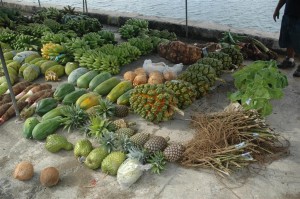Preserving Knowledge of Traditional Plants in Micronesia
Posted in People, Science on July 8 2009, by Plant Talk
 |
Wayne Law, Ph.D., is a Postdoctoral Research Associate who studies ecology, ethnobotany, and conservation in Micronesia. Come speak with him at our Café Scientifique on July 9, from 6 to 8 p.m., in the Conservatory Courtyard as part of The Edible Garden. |
 When someone asks you to visualize a banana, most people in the United States will picture the typical, slightly curved, yellow-skinned banana with a bland white flesh that can be found at local grocery stores. However, a number of different varieties exist: small bananas, straight bananas, red-skinned bananas, creamy-tasting bananas—even bananas that have a bright-orange flesh—and many of these varieties can be found on tiny islands in the Pacific known as Micronesia, where Botanical Garden scientists are conducting research.
When someone asks you to visualize a banana, most people in the United States will picture the typical, slightly curved, yellow-skinned banana with a bland white flesh that can be found at local grocery stores. However, a number of different varieties exist: small bananas, straight bananas, red-skinned bananas, creamy-tasting bananas—even bananas that have a bright-orange flesh—and many of these varieties can be found on tiny islands in the Pacific known as Micronesia, where Botanical Garden scientists are conducting research.
One of our goals in Micronesia is to record traditional plant knowledge that is the foundation of these islands’ unique cultures. The plant knowledge throughout this region is incredibly diverse as plants are integral to all aspects of daily island life, from the construction of houses and canoes to use as medicines and foods. As traditional ways of life are influenced by modern amenities, we are constantly seeing evidence that traditional plant knowledge is being lost and that many common items once made from nature are being replaced by plastic products that have an origin thousands of miles away. One study we conducted analyzed the knowledge of food plant varieties in Kosrae, the easternmost island of the Micronesia chain.
By the early 1900s, Kosrae, an island home to 7,000 people in the Eastern part of Micronesia, had already been exposed to French and Russian explorers, whalers, beachcombers, pirates, and traders, beginning the erosion of what had been a very traditional Pacific island lifestyle. At that time, Ernst Sarfet, a German ethnographer, documented much of Kosrae’s cultural aspects and plant uses during the Hamburg South Seas expedition, an impressive voyage that lasted two years and produced a 13-volume publication based on the observations made during the expedition. The translated work provides an early record of the different varieties of bananas, breadfruit, coconuts, pandanus, sugar cane, soft and hard taro, and yams. (The photo shows a display of some of the fruits and vegetables mentioned, during a holiday celebration in Kosrae.)
Almost 100 years later, while compiling information for our series of ethnobotany books for the area, we compared Sarfet’s list to the present day knowledge of men and women of three different age classes (20–40, 40–60, and 60–80 year olds). We found that many of the traditional varieties of these food plants have been forgotten by the younger generations and have been replaced by modern varieties. This phenomenon occurs elsewhere throughout the region as local varieties are becoming displaced by off-island introductions. Local varieties like the “Karat” banana, found in Pohnpei and rich in provitamin A (100 times more than found in commercial bananas), carotenoids, lutein, riboflavin, niacin, and vitamin E, are being forgotten for less-nutritious varieties.
Efforts of the Island Food Group of Pohnpei, a local non-governmental organization promoting the growth and consumption of local varieties, have encouraged an active role of the community to prevent the loss of the local food types. Information on useful plants in Pohnpei has also been documented in the recently released book by Michael Balick, Ph.D., Vice President for Botanical Science at the Garden, Ethnobotany of Pohnpei: Plants, People, and Island Culture—available at Shop in the Garden—with a similar book currently being compiled for Kosrae.
As a 21st-century scientist working in Micronesia, I am following in the footsteps of Ernst Sarfet, nearly 100 years later, looking at the same landscape he studied and observing how it has evolved since his time. Micronesia has some of the most pristine habitats in the world, where plant species that grow nowhere else can be found in great numbers.

